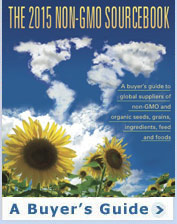New certification programs aim to encourage sustainable farming
Food Alliance and Protected Harvest certify farmers for adopting sustainable agricultural practices without going completely organic.
For many conventional farmers, making the transition to organic is a huge step with financial risks. To bridge the gap, certification programs have emerged that reward farmers for adopting sustainable agricultural practices, such as reduced pesticides, fair compensation for workers, humane treatment of livestock, and soil and water conservation.
Food Alliance
Food Alliance, based in Portland, Oregon, offers a voluntary certification
and eco-labeling program based on standards developed to define socially
and environmentally responsible agricultural practices. The standards
focus on five areas: pesticide reduction, soil and water conservation,
wildlife preservation, fair and safe working conditions, and humane
livestock care.
The standards also prohibit the use of genetically modified seed. However, Matthew Buck, Food Alliance assistant director, says the standards are flexible about the use of GM animal feed. “We would probably like to move to a strict prohibition, but we have to respect the folks we certify and difficulties they face in guaranteeing there is no GMO content.”
Food Alliance certifies 225 small to mid-size farms and ranches in the United States, encompassing 3.8 million acres. Certified products include beef, pork, lamb, dairy, grains, beans, lentils, and processed fruits, and vegetables. “It covers the whole supermarket,” says Buck.
Demand for Food Alliance certification is increasing. Since 2002, the number of certified farms and ranches has increased 25 percent, and sales of certified products have increased by 70 percent. “There are more farms, larger farms, and a lot more sales (of certified products),” says Buck.
Protected Harvest certifies large-scale farms
Like Food Alliance, Protected Harvest is a sustainable certification
program that aims to stimulate greater market acceptance for agricultural
products grown using sustainable methods.
Unlike Food Alliance, which certifies small- to mid-size farms, Protected Harvest encourages adoption of sustainable practices among large-scale farms.
Protected Harvest began as a collaboration of the World Wildlife Fund, the Wisconsin Potato and Vegetable Growers Association, and the University of Wisconsin, aiming to reduce pesticide usage among Wisconsin potato farms. In 2001, Protected Harvest was established as an independent certification program to certify the potatoes. Today, Protected Harvest certifies 10,000 acres of Wisconsin potato farms. The farms’ Healthy Grown® Potatoes display Protected Harvest’s certification seal.
To be certified with Protected Harvest, farmers must earn a minimum number of points implementing sustainable practices in nine areas, such as pest, weed, insect, and disease management and soil and water quality. Farmers must stay below an established total number of toxicity units per acre with pesticide usage.
In August 2005, Protected Harvest received grants from
California’s
State Water Resources Control Board and the US Environmental Protection
Agency to create standards for sustainable tomato production in California.
Other Protected Harvest certification programs are underway at vineyards,
a strawberry farm and peach orchards in California.
Rainforest Alliance
The Rainforest Alliance, based in New York, works with farmers in developing
nations to bring their operations up to standards for protecting wildlife,
wild lands, workers’ rights, and local communities. Rainforest
Alliance certifies coffee, bananas, cocoa, and citrus. Certified products
include Chiquita bananas and Kraft Foods’ Yuban coffee. These
products display the Rainforest Alliance eco-label.
As with other sustainable certification programs, Rainforest Alliance requires that clients, such as Chiquita, reduce, but not eliminate pesticides. “If we asked to them to eliminate pesticides, we would put farmers out of business. It is very hard to grow organic bananas,” says Jennifer Vogel, communications coordinator.
“Organic lite” or helping farmers?
Sustainable certification programs fall into the category of eco-labels,
which are appearing on more and more consumer products. Other such labels
include “Fair Trade Certified,” “Bird Friendly,” and “Certified
Humane Raised and Handled,” to name a few.
Critics deride sustainable certification as “organic lite.” In a letter to Protected Harvest, Paul Hawken, sustainable economy expert, wrote, “To take a type of transitional agriculture that actually never aims to make the transition and call that sustainable is unscientific, and betrays the term.”
Jake Lewin, marketing director with organic certifier CCOF, says programs that help farmers adopt more sustainable methods are good. But he also says eco-labels create confusion for consumers. “There is enough label confusion in the marketplace as it is.” Moreover, Lewin says sustainable certification is an intermediate step when further development of organic is needed. “I would rather see eco-labels that push organic further.”
But Fred Kirschenmann, distinguished fellow, Leopold Center for Sustainable Agriculture, and an organic farmer, sees sustainable certification, particularly Food Alliance, helping farmers transition to organic. “It provides another option for farmers,” he says. “For many farmers, making the transition from conventional to organic is very foreboding, but if we have a production system that allows growers to test out options and get a premium while they are transitioning to organic, it makes it much more feasible for them.”
Traceability, accountability, transparency
Buck says increasing consumer awareness of healthier foods is driving
demand for sustainable food programs such as Food Alliance. “Consumers
are seeking high value, highly differentiated products, and products
with a story.”
There are also growing demands for traceability,
accountability, and transparency in the food industry, and programs,
such as Food Alliance and Protected Harvest, not to mention organic
and non-GMO certification, help meet this need. “We will see growth
of certified products of all kinds,” says Buck.
Copyright 2006. The Organic & Non-GMO Report (July 2006).




